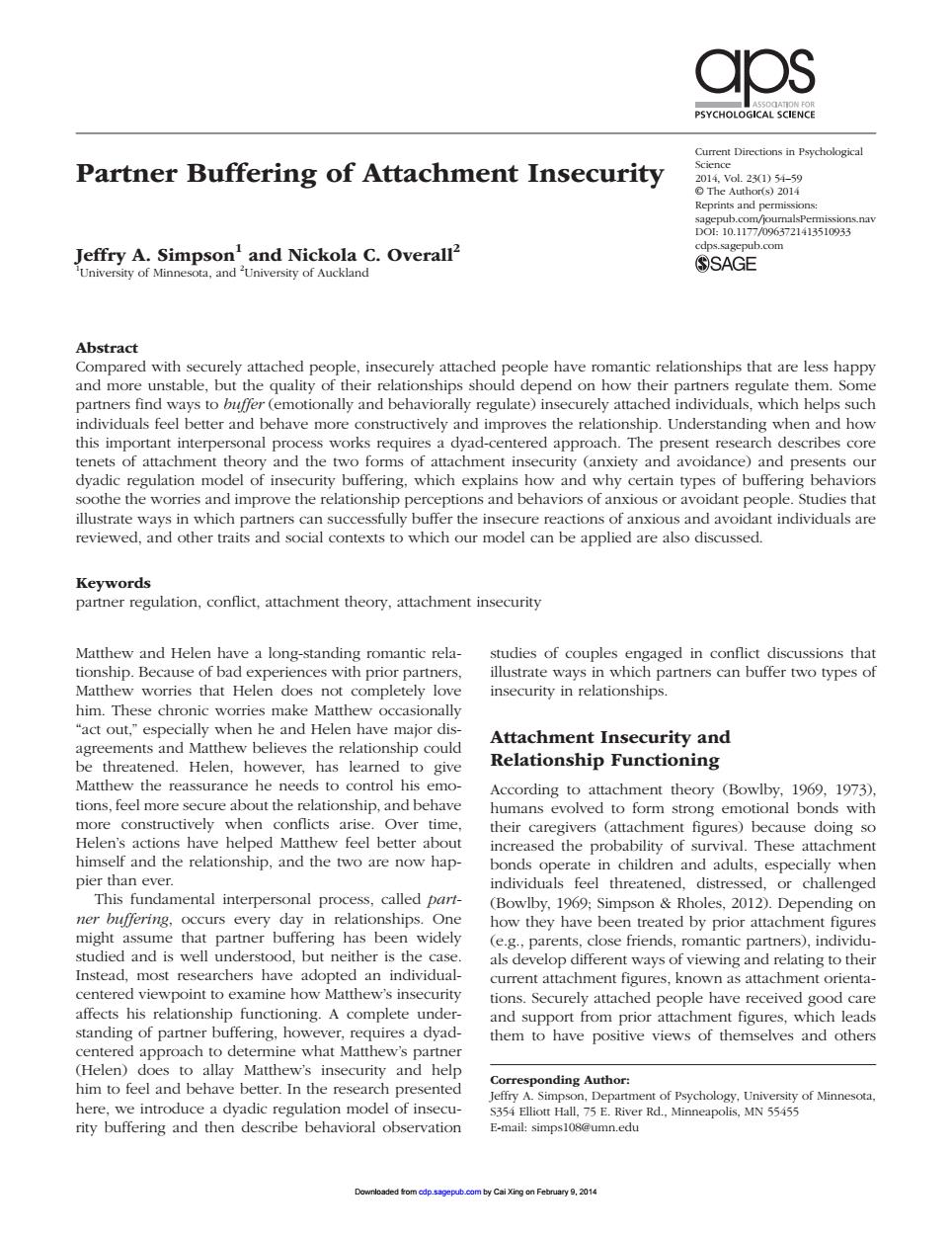正在加载图片...

as SYCH Partner Buffering of Attachment Insecurity ts and Jeffry A.Simpson'and Nickola C.Overall2 niversity of Minnesota,and "University of Auckland SAGE Abstract t are less happy and mor me quali which uctively and impm ves the relationship.Understanding this important interpersonal proce s works requires a dyad-centered approach.The present research describes core ng,wncn exp l strate ways in which n can successfully buffer the insecure reactions of anxious and ay nt individualsar reviewed.and other traits and social contexts to which our model can be applied are also discussed. partner regulation,conflict,attachment theory,attachment insecurity Matthew and Helen have a long-standing romantic rela- studies of couples engaged in conflict discussions that tionship.Because of ba ers. The wo tionships act out ially when hea agreements and Matthew believes the relationship could Attachment Insecurity and be threater ned.Helen,however,has learned to give Relationship Functioning Matt e he ne According to attachment theory (Bowlby,1969,1973). more se out the tim humans evolved to form strong emotional bonds with Helen's actions have helped Matthew feel better about nent nigure because doing sc himself and the relationship,and the two are now hap bonds operate in children and adults,especially wher pie ntal interpe individuals feel threatened,distressed,or challenged (Bowlby,1969:Simpson Rholes,2012).Depending on w they have be als develop different ways of viewing and relating to thei Instead. most rchers current attachment figures,known as attachment orienta- cts his tions.Securely attached people have received good car e p (Heler and allay Matthew ecurity and help etter.In reseade of in ment of Psychole rity buffering and then describe behavioral observation u201 Current Directions in Psychological Science 2014, Vol. 23(1) 54–59 © The Author(s) 2014 Reprints and permissions: sagepub.com/journalsPermissions.nav DOI: 10.1177/0963721413510933 cdps.sagepub.com Matthew and Helen have a long-standing romantic relationship. Because of bad experiences with prior partners, Matthew worries that Helen does not completely love him. These chronic worries make Matthew occasionally “act out,” especially when he and Helen have major disagreements and Matthew believes the relationship could be threatened. Helen, however, has learned to give Matthew the reassurance he needs to control his emotions, feel more secure about the relationship, and behave more constructively when conflicts arise. Over time, Helen’s actions have helped Matthew feel better about himself and the relationship, and the two are now happier than ever. This fundamental interpersonal process, called partner buffering, occurs every day in relationships. One might assume that partner buffering has been widely studied and is well understood, but neither is the case. Instead, most researchers have adopted an individualcentered viewpoint to examine how Matthew’s insecurity affects his relationship functioning. A complete understanding of partner buffering, however, requires a dyadcentered approach to determine what Matthew’s partner (Helen) does to allay Matthew’s insecurity and help him to feel and behave better. In the research presented here, we introduce a dyadic regulation model of insecurity buffering and then describe behavioral observation studies of couples engaged in conflict discussions that illustrate ways in which partners can buffer two types of insecurity in relationships. Attachment Insecurity and Relationship Functioning According to attachment theory (Bowlby, 1969, 1973), humans evolved to form strong emotional bonds with their caregivers (attachment figures) because doing so increased the probability of survival. These attachment bonds operate in children and adults, especially when individuals feel threatened, distressed, or challenged (Bowlby, 1969; Simpson & Rholes, 2012). Depending on how they have been treated by prior attachment figures (e.g., parents, close friends, romantic partners), individuals develop different ways of viewing and relating to their current attachment figures, known as attachment orientations. Securely attached people have received good care and support from prior attachment figures, which leads them to have positive views of themselves and others 510933 CDPXXX10.1177/0963721413510933Simpson, OverallPartner Buffering of Attachment Insecurity research-article2014 Corresponding Author: Jeffry A. Simpson, Department of Psychology, University of Minnesota, S354 Elliott Hall, 75 E. River Rd., Minneapolis, MN 55455 E-mail: simps108@umn.edu Partner Buffering of Attachment Insecurity Jeffry A. Simpson1 and Nickola C. Overall2 1 University of Minnesota, and 2 University of Auckland Abstract Compared with securely attached people, insecurely attached people have romantic relationships that are less happy and more unstable, but the quality of their relationships should depend on how their partners regulate them. Some partners find ways to buffer (emotionally and behaviorally regulate) insecurely attached individuals, which helps such individuals feel better and behave more constructively and improves the relationship. Understanding when and how this important interpersonal process works requires a dyad-centered approach. The present research describes core tenets of attachment theory and the two forms of attachment insecurity (anxiety and avoidance) and presents our dyadic regulation model of insecurity buffering, which explains how and why certain types of buffering behaviors soothe the worries and improve the relationship perceptions and behaviors of anxious or avoidant people. Studies that illustrate ways in which partners can successfully buffer the insecure reactions of anxious and avoidant individuals are reviewed, and other traits and social contexts to which our model can be applied are also discussed. Keywords partner regulation, conflict, attachment theory, attachment insecurity Downloaded from cdp.sagepub.com by Cai Xing on February 9, 2014